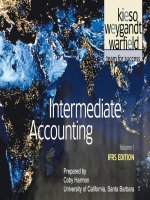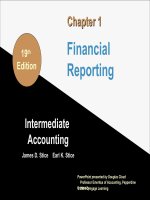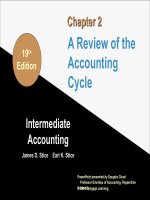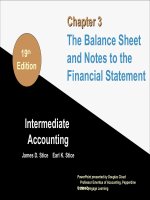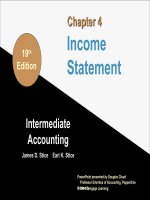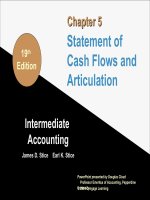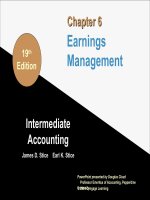Intermediate accounting 19th by stice stice chapter 13
Bạn đang xem bản rút gọn của tài liệu. Xem và tải ngay bản đầy đủ của tài liệu tại đây (201.5 KB, 79 trang )
Chapter 13
19th
Edition
Equity
Financing
Intermediate
Accounting
James D. Stice
Earl K. Stice
PowerPoint presented by Douglas Cloud
Professor Emeritus of Accounting, Pepperdine
University
© 2014 Cengage Learning
13-1
Nature and Classifications
of Paid-In Capital
•
•
•
A corporation is a legal artificial entity
separate from its owners.
Individuals contribute capital for which
the corporation issues stock certificates
evidencing ownership interests.
Stockholders elect a board of directors
whose members oversee the strategic
and long-run planning of the corporation.
13-2
Common and Preferred Stock
•
•
When a corporation is formed, a single class
of stock, known as common stock, is
usually issued.
Corporations may later find that there are
advantages to issuing one or more additional
classes of stock with varying rights and
priorities. Stock with certain preferences
(rights) over common stock is called
preferred stock.
13-3
Common Stock
Unless restricted by terms of the articles of
incorporation, certain basic rights are held by
each common stockholder:
1. To vote in the election of directors and in
the determination of certain corporate
policies.
2. To maintain one’s proportional interest in
the corporation through purchase of
additional common stock if and when it is
issued. This right is known as the
preemptive right.
13-4
Par or Stated Value of Stocks
The journal entry to record the issuance of
common stock in exchange for cash
frequently looks something like this:
Cash
Common Stock (at par value)
XXX
Additional Paid-In Capital
XXX
XXX
(continued)
13-5
Par or Stated Value of Stocks
•
•
•
Historically, par value was equal to the
market value of the shares at issuance.
Today, most stocks have a nominal par
value or no par value at all.
No-par stock sometimes has a stated
value that for financial reporting purposes
acts like a par value.
(continued)
13-6
Preferred Stock
•
The term preferred stock is somewhat
misleading because it gives the impression
that preferred stock is better than common
stock.
•
•
Preferred stock isn’t better—it’s different.
Preferred stockholders give up many of the
rights of ownership in exchange for some
of the protection enjoyed by creditors.
(continued)
13-7
Preferred Stock
Rights of ownership given up by preferred
stockholders:
• Voting. In most cases, preferred stockholders
are not allowed to vote for the board of
directors.
•
Sharing in success. The cash dividends
received by preferred stockholders are usually
fixed in amount. Therefore, if the company
does exceptionally well, preferred stockholders
do not get to share in the success.
(continued)
13-8
Preferred Stock
The protections enjoyed by preferred stockholders,
relative to common stockholders, are:
• Cash dividend preference. Preferred
stockholders are entitled to receive the full
cash dividend before any cash dividends are
paid to common stockholders.
•
Liquidation preferences. If the company goes
bankrupt, preferred stockholders are entitled to
have their investment repaid, in full, before
common stockholders receive anything.
13-9
Cumulative and Noncumulative
Preferred Stock
•
When a corporation fails to declare dividends
on cumulative preferred stock, such
dividends accumulate and require payment in
the future before any dividends may be paid to
common stockholders.
•
Dividends on cumulative preferred stock that
are passed are referred to as dividends in
arrears.
•
With noncumulative preferred stock, it is not
necessary to provide for passed dividends.
13-10
Participating Preferred Stock
•
Participating preferred stock issues
provide for additional dividends to be paid to
preferred stockholders after dividends of a
specified amount are paid to the common
stockholders.
•
A participating provision makes preferred
stock more like common stock.
•
Participating preferred stocks are now
relatively rare.
13-11
Convertible Preferred Stock
•
•
•
Preferred stock is convertible when it
can be exchanged by its owner for some
other security of the issuing corporation.
Conversion rights generally provide for
the exchange of preferred stock into
common stock.
In some instances, preferred stock may
be converted into bonds.
13-12
Callable Preferred Stock
•
•
Many preferred issues are callable,
meaning they may be called and
canceled at the option of the
corporation.
The call price is usually specified in the
original agreement and provides for
payment of dividends in arrears as part
of the repurchase price.
13-13
Redeemable Preferred Stock
•
Redeemable preferred stock is preferred
stock that is redeemable at the option of
the stockholder or upon other conditions
not within the control of the issuer.
•
Redeemable preferred stock is somewhat
like a loan in that the issuing corporation
may be forced to repay the stock
proceeds.
13-14
Current Development in The
Accounting for Preferred Stock
•
In the Preliminary Views document, the
FASB recommends the “basic ownership
approach” to identifying equity.
•
This approach hinges on the idea that equity
claims are those that remain when all other
claims have been satisfied.
•
The basic ownership approach would be very
restrictive. In fact, all preferred stock, whether
redeemable or not, would be reported as a
liability under this approach.
(continued)
13-15
Current Development in The
Accounting for Preferred Stock
•
Users prefer a “perpetual approach,” which
describes an equity instrument as one for
which there is no requirement to repay the
invested funds, and the holder of the
instrument is entitled to some assets if the
company is liquidated.
•
Both the FASB and IASB are leaning toward
the “perpetual approach.”
13-16
Capital Stock Issued for Cash
•
•
The issuance of stock for cash is recorded
by a debit to Cash and a credit to Capital
Stock for the par value.
When the amount of cash received for the
stock is more than the par value, the
excess is recorded as a credit to an
additional paid-in capital account.
(continued)
13-17
Capital Stock Issued for Cash
Par
ParValue
Value Stock
Stock
Goode Corporation issued 4,000 shares of $1
par common stock on April 1, 2011, for
$45,000 cash.
2011
Apr. 1 Cash
Common Stock
4,000
Paid-In Capital in Excess
of Par
41,000
(continued)
45,000
13-18
Capital Stock Issued for Cash
Stated
Stated Value
ValueStock
Stock
On April 1, 2011, Goode Corporation issued
4,000 shares of no-par common stock with a
$1 stated value.
2011
Apr. 1 Cash
Common Stock
4,000
Paid-In Capital in Excess
of Stated Value
(continued)
41,000
45,000
13-19
Capital Stock Issued for Cash
No-Par
No-ParStock
Stock
On April 1, 2011, Goode Corporation issued
4,000 shares of no-par common stock for
$45,000 cash.
2011
Apr. 1 Cash
Common Stock
45,000
45,000
13-20
Capital Stock Sold on Subscription
•
A subscription is a legally binding contract
between the subscriber (purchaser of stock)
and the corporation (issuer of stock).
•
The contract states the number of shares
subscribed, the subscription price, the terms of
payment, and other conditions of the
transaction.
•
Ordinarily, stock certificates are not issued
until the full subscription price has been
received by the corporation.
13-21
Subscription Defaults
If a subscriber defaults on a subscription, a
corporation may:
1) return to the subscriber the amount paid,
2) return to the subscriber the amount paid less
any reduction in price or expense incurred on
the resale of the stock,
3) declare the amount paid by the subscriber as
forfeited, or
4) issue to the subscriber shares equal to the
number paid for in full.
13-22
Reasons Companies
Repurchase Stock
1. Provide shares for incentive compensation
and employee savings plans.
2. Obtain shares needed to satisfy requests by
holders of convertible securities.
3. Reduce the amount of equity relative to the
amount of debt.
4. Invest excess cash temporarily.
5. Remove some shares from the open market
in order to protect against a hostile takeover.
(continued)
13-23
Reasons Companies
Repurchase Stock
6. Improve per-share earnings by reducing the
number of shares outstanding and returning
inefficiently used assets to shareholders.
7. Display confidence that the stock is
currently undervalued by the market.
13-24
Treasury Stock
•
•
•
•
Treasury stock is stock issued by a corporation
and subsequently reacquired by the corporation
and held for possible future reissuance or
retirement.
Treasury stock should not be viewed as an
asset; report as a reduction in owner’s equity.
There is no income or loss on the reacquisition,
reissuance, or retirement of treasury stock.
Retained Earnings can be decreased by
treasury stock transactions but never increased
by such transactions.
13-25

